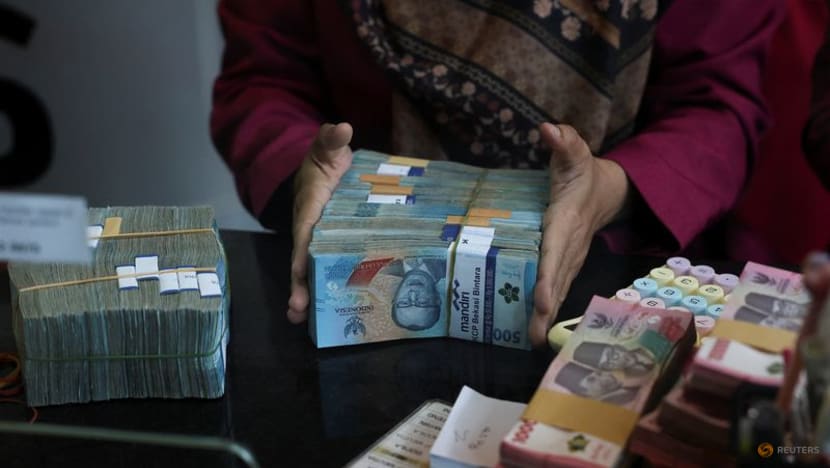Commentary: Weak rupiah could benefit Indonesia in Trump’s trade war
The rupiah had been sliding even before Trump's latest round of tariffs – but the country and the rest of Southeast Asia remain resilient in the longer-term, says UOB economist Enrico Tanuwidjaja.

A teller prepares rupiah bank notes at a money changer in Jakarta, Indonesia, Apr 9, 2025. REUTERS/Willy Kurniawan

This audio is generated by an AI tool.
SINGAPORE: Southeast Asian currencies have staged a remarkable rebound since United States President Donald Trump announced sweeping tariffs on Apr 2.
Despite initial weakness on fears that their economies will tank, currencies have strengthened against the US dollar, even as the White House walked back on the most punishing tariffs. This is mainly due to US dollar weakness, with expectations that the US Federal Reserve would soon need to cut rates to boost its economy.
However, that has not saved the Indonesian rupiah, which hit its lowest levels since the 1997 to 1998 Asian Financial Crisis. Before Mr Trump’s tariffs, Indonesia’s central bank was forced to step in on Mar 25 to defend the currency.
The rupiah fell to an all-time low of 16,970 against the US dollar on Apr 9 as markets roiled from Mr Trump's reciprocal tariffs. Though the rupiah has rebounded from its trough, it has been one of the worst-performing Asian currencies on a year-to-date basis.
Indonesia’s stock market also plunged this year, with non-residents recording a net sell-off of about US$1.8 billion in stocks and bonds on a year-to-date basis.
INVESTOR CONCERNS
Investors are concerned about the impact on the US tariffs on Indonesia’s near-term growth prospects. Palm oil, footwear, low-value electrical apparatus, apparel and furniture are the sectors that will suffer from lower exports to the US.
After all, Indonesia's economy - and its currency - had benefitted from its booming trade surplus with the US. Indonesia's trade surplus with the US has grown in recent years, reaching its peak of US$16.9 billion in 2024.
Mr Trump’s tariffs threaten to unwind this.
The unfavourable external environment adds to concerns over domestic policy. Markets have been spooked by the rapid changes by Indonesia’s new president Prabowo Subianto over the past year. His government's enhanced social spending, such as free lunches in schools, has put further strain on the already-stretched government budget.
There are also concerns over Bank Indonesia’s independence and the country’s alleged use of debt monetisation – the controversial practice of funding government spending by issuing bonds that are then purchased by the central bank.
Since central banks can print as much of the local currency as they want, critics say that debt monetisation is basically a process of printing money to fund spending. This can potentially cause inflation, currency devaluation and a loss of confidence in the government’s fiscal management.
In Indonesia’s case, the central bank seems to be leaning towards giving all-out support to finance government spending. It will buy government bonds to finance the construction of low-cost homes, for example.
Bank Indonesia is now the largest holder of the outstanding government securities with a share of 28 per cent – up significantly from 9 per cent before the pandemic.
RELATIVELY MUTED REGIONAL IMPACT
On a positive note, the economic situation today is much brighter than the dark days of 1998.
During the Asian Financial Crisis, the rupiah’s annualised loss was almost 650 per cent – meaning that the currency would have a negative value if the depreciation pressure had continued. This year’s losses would only be about 16 per cent if they were to run all the way to December.
One should not focus entirely on the currency levels but also at the rupiah’s rate of depreciation, which is much gentler today despite Mr Trump’s sweeping tariffs.
Regional international reserves today are far more robust and economies are stronger. The foundations are firm, and short sellers are not circling like hawks like they were in 1998.
In addition, there is belief in some quarters that Mr Trumps’ tariffs are more of a tactic to bring countries to the negotiation table to improve the US’ trade positions.
Nonetheless, with exports to the US likely to fall for many Southeast Asian countries, the race is on within the region for ways to make up the shortfall. Fears could arise over competitive devaluation between regional markets.
With the weakening rupiah, one possibility is that Indonesian exports will benefit at the expense of exports from Singapore, Malaysia, Thailand or Vietnam. In this regard, it is fortunate for the region that Indonesia has a lower manufacturing base than its peers in Southeast Asia.
Manufacturers will be the top beneficiary from any currency weakness. As a country that is still largely driven by domestic consumption, wholesale and retail, Indonesia’s currency weakness will have limited negative ramifications for the region.
While the jury is out over the ongoing trade war and its impacts, we have lowered our previous 2025 growth forecast for Indonesia from 5.2 per cent to 4.9 per cent. At least we are not looking at second-order complications from falling currencies.
STRUCTURAL REFORMS HAVE SOME PROMISE
While Mr Prabowo’s social initiatives have contributed to investors’ fears, his spending programmes may ironically tide his country through the weak external environment.
Social assistance programmes and the provision of free nutritious meals will support household spending in the near term, somewhat offsetting the worries from weaker foreign direct investment flows and commodity exports.
The current government is doing right to pursue investment-led strategies so that the country can improve on its recent average of 5 per cent annual growth.
It will be a complicated path. Mr Prabowo will need to provide the right incentives, sustain them, and target investments that will raise productivity significantly and employ many people. In addition, the country needs to engage more private sector participation to support higher investment spending.
It may take a few more years due to the current trade war, but Indonesia will eventually unleash its higher economic potential. And while the rupiah has led the way downwards for Asian currencies this year, Southeast Asia’s largest economy may yet lead the way upwards for regional growth in the years ahead.
Enrico Tanuwidjaja is ASEAN economist at UOB. His coverage focuses on Indonesia and Thailand.
















